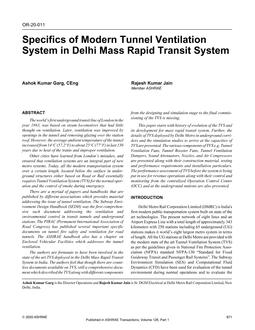Description
The world’s first underground transit line of London in the year 1863, was based on steam locomotives that had little thought on ventilation. Later, ventilation was improved by openings in the tunnel and removing glazing over the station roof. However, the average ambient temperature of the tunnel increased from 14°C (57.2°F) to about 25°C (77°F) in last 150years due to heat of the trains and improper ventilation.
Other cities have learned from London’s mistakes, and ensured that ventilation systems are an integral part of newmetro systems. Today, all the modern transportation systemover a certain length, located below the surface in underground structures either based on Road or Rail essentially requires Tunnel Ventilation System (TVS) for the normal operation and the control of smoke during emergency.
There are a myriad of papers and handbooks that are published by different associations which provides material addressing the issue of tunnel ventilation. The Subway Environment Design Handbook (SEDH) was the first comprehensive such document addressing the ventilation and environmental control in transit tunnels and underground stations. The PIRAC (Permanent International Association of Road Congress) has published several important specific documents on tunnel fire safety and ventilation for road tunnels. The ASHRAE handbook also has a chapter on Enclosed Vehicular Facilities which addresses the tunnelventilation.
The authors are fortunate to have been involved in thestate of the art TVS deployed in the Delhi Mass Rapid TransitSystem in India. The authors feel that though there are countlessdocuments available on TVS, still a comprehensive documentwhich described the TVS along with different componentsfrom the designing and simulation stage to the final commissioningof the TVS is missing.
This paper starts with history of evolution of the TVS andits development for mass rapid transit system. Further, thedetails of TVS deployed by Delhi Metro in underground corridorsand the simulation studies to arrive at the capacities ofTVS are presented. The various components of TVS e.g. TunnelVentilation Fans, Tunnel Booster Fans, Tunnel VentilationDampers, Sound Attenuators, Nozzles, and Air Compressorsare presented along with their construction material, testingand performance requirements and installation particulars.The performance assessment of TVS before the system is beingput in use for revenue operations along with their control andmonitoring from the centralized Operation Control Center(OCC) and at the underground stations are also presented.
Product Details
- Published:
- 2020
- Number of Pages:
- 20
- Units of Measure:
- Dual
- File Size:
- 1 file , 3.4 MB
- Product Code(s):
- D-OR-20-011




